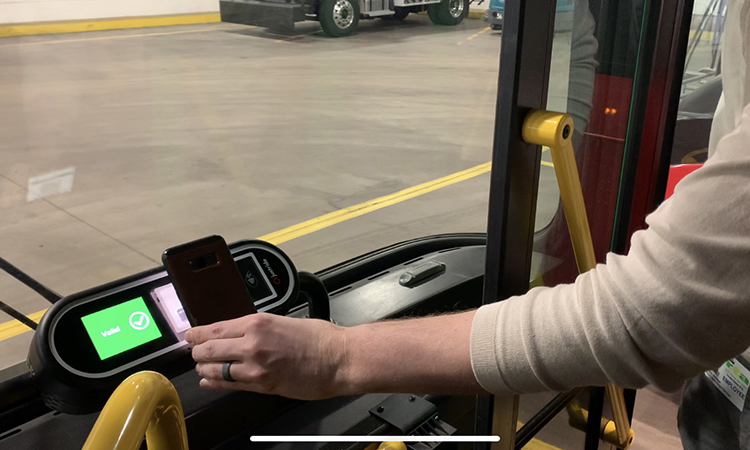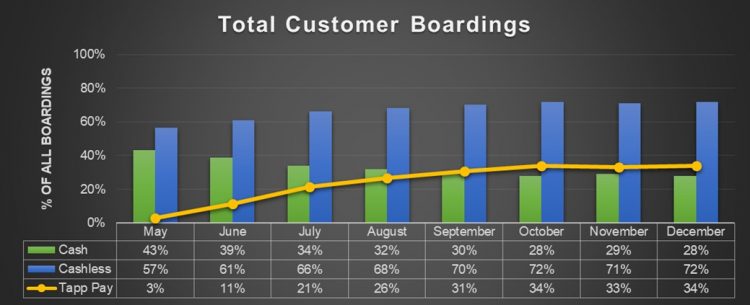Creating a cashless and accessible fare system in Dayton, Ohio
- Like
- Digg
- Del
- Tumblr
- VKontakte
- Buffer
- Love This
- Odnoklassniki
- Meneame
- Blogger
- Amazon
- Yahoo Mail
- Gmail
- AOL
- Newsvine
- HackerNews
- Evernote
- MySpace
- Mail.ru
- Viadeo
- Line
- Comments
- Yummly
- SMS
- Viber
- Telegram
- Subscribe
- Skype
- Facebook Messenger
- Kakao
- LiveJournal
- Yammer
- Edgar
- Fintel
- Mix
- Instapaper
- Copy Link
Posted: 14 January 2021 | Brandon Policicchio - Greater Dayton RTA | No comments yet
Brandon Policicchio of Greater Dayton RTA talks cashless fares, and explains what his authority is doing to make transit accessible for everyone.


Greater Dayton RTA's mobile payment system grew from strength to strength in 2020.
At Greater Dayton RTA, like all transit agencies across the US, we continue to focus on maintaining safe and quality operations amid the pandemic for our customers. Since the start of the pandemic, we have remained committed to providing full service despite experiencing dramatic ridership drops – at one time it was over 50 percent below figures from last year. Today, we are serving about 70 percent of our pre-pandemic customer levels who rely on us for their essential travel needs.
Prior to 2020, we began the process of upgrading to our new fare payment system, called Tapp Pay, along with the continual development of our Mobility-as-a-Service (MaaS) platform provided by Transit. Assisting us in our fare payment system upgrade are our partners Masabi and Transit.
While the pandemic created some temporary obstacles in the initial delivery of the project, we were able to accelerate the first phase of our upgrade. We did this to help support customers who were seeking a safer, contactless way to pay for their services due to pandemic concerns.
On 1 June 2020, we delivered mobile payments, and as of December 2020 over 6,000 customers have purchased more than 45,000 passes. Based on data analysis from the new and legacy fare payment systems, it is estimated that 34 percent of our daily boardings are representative of customers utilising the Tapp Pay system.


The rise of cashless payments is made quite clear by data provided by greater Dayton RTA.
Getting off to a great start with customer adoption of mobile payments remains critical, as we will transition all our customers to a 100 percent cashless on-board payment experience by summer 2021.
Progress has been made since launching in June 2020 and we have seen a reduction of on-board cash payments from 43 percent of all fare box transactions in January 2020 to just 28 percent in December 2020. In addition, we have seen a 9 percent reduction in customers using cash only as payment when boarding.
Our goal is to ensure equity and universal access while providing a cashless on-board payment experience. Therefore, in November 2020, we offered customers the opportunity to pay for mobile passes with cash at participating local retail outlets and our main transit center sales outlet.
We partnered with one of our two cashless technology partners, T-CETRA, to deliver this feature. The target audience for this feature is customers who own a smartphone but do not have access to a debit or credit card. Not only does this provide additional access to customers, but there are no fees for this service, whereas other options such as pre-paid debit card payments often charge monthly or other card transactional fees.
With the help of our partners at Transit, the app we use to facilitate mobile payments, and Masabi, our fare payment system provider and integrator, we will release additional phases of the Tapp Pay system throughout the first half of 2021. This includes smartcards for customers who do not have a smartphone, an expansion of over 100 additional cash conversion retail outlets conveniently located near bus routes, and fare payment kiosks at all transit centers.
Our goal is to ensure equity and universal access while providing a cashless on-board payment experience.”
As we progress through the year, we will launch other critical payment system features. Such features include fare capping and the ability for customers to carry a low or even one-time negative balance to ensure that one trip can be made to load more fares.
All features will be made available on our Tapp Pay mobile and smartcard payment platforms and by summer 2021, they will be the only forms of payment available when boarding any bus route, paratransit service, and other demand-response services.
Collectively, these features will ensure our cashless on-board system is accessible for customers who are unbanked and underbanked. In addition, we will deliver fare equity through fare capping for our customers who are least able to pay the upfront costs of monthly passes, and as a result traditionally end up paying the most at the end of the month.
Biography
With over 10 years of experience in the industry, Brandon Policicchio began his career in 2006 as a student bus operator at The Ohio State University while earning his bachelor’s degree.
As Chief Customer and Business Development Officer with the Greater Dayton RTA, Brandon leads his department in the management, development and implementation of RTA’s bus route planning and scheduling, information technology, communications, community relations, customer service, bike share, paratransit, and other demand-response services. His team’s core focus is on the customer and achieving RTA’s vision of universal access to a multi-modal mobility network.
Related topics
Accessibility, COVID-19, Infrastructure & Urban Planning, Passenger Accessibility, Passenger Experience, Public Transport, Ticketing & Payments, Transport Governance & Policy, Travel & Passenger Information, Vehicle & Passenger Safety
Related modes
Bus & Coach
Related cities
Ohio
Related organisations
Greater Dayton RTA








